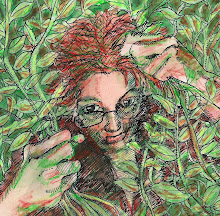I'm not done with the black and white prints at all, but I'm taking a print-making class. The class I signed up for (Experimental Print Media) was cancelled because not enough people signed up for it, so after long deliberation I decided to take Beginning Printmaking instead. It's the same price as just doing open studio, so instead of just having access to the print studio any time, you get a class too--and get to meet people and learn some new things, which I figured I'd do, since there's a lot of stuff about these relief prints I just don't know yet.
So I go on Monday night, the second meeting of the class (because I missed the first one not having decided to take the class yet), and find that the first project is a three-color reduction linocut. What????? This is a beginning class. There are a couple of people in there who have never done any printmaking before, and instead of giving them little blocks and having them experiment with cutting (which I did on several little blocks back in August--http://www.augustcoreopsis.blogspot.com/2013/08/must-make-linocuts.html), everyone is given a 6X8 block, mounted on wood, to make a three-color-reduction print. Today they were all to start cutting for printing the first color (which would be the lightest color, with white where you've cut away), and the mix inks for printing these three colors.
All I have to say is "Whoa! Aren't we jumping the gun here a little?"
If I were teaching the class, I'd have everyone practicing cutting and making marks first--which we did spend about two minutes each doing on a practice block for the whole class. But I'd have everyone practice a lot. And then practice printing those little experimental blocks. And then I'd have folks design an image for a one-color linocut. That takes quite a bit of thinking. I did 22 of those little ones, and though I feel a lot more confident and comfortable with the process now, there are still many design problems to be solved.
This reduction color-block seems a pretty advanced technique to me. I couldn't go to sleep for hours after the class, trying in my head to imagine what kind of design would work for this, HOW it would work, barely getting to wrap my head around it.
So I took the day off work yesterday to make some practice ones (actually, I took the day off work because my son had just returned from Paris late the night before and it was his birthday, but in between driving him around and making birthday cake, all I did was work on prints). I went to the local hobby store and bought some different colors of ink, so I'd have something to practice with (and yes, I could have gone to the studio and used the inks there, but sine it was my son's first day home, I wanted to be home).It was only after having made the first one (Face #23, above) that I started to be able to see what I could possibly do. And I could only make the first one after looking at a lot of examples in books and online.
I'm still going to go to the studio this weekend and print a lot of little tiny things to see how the inks there interact with each other. It makes a different in what kind of cutting I'll do, and what kind of colors I'll use, and ALL of it is information I need before I'm ready to cut this mounted block I've been given. I don't want that block to be a disaster, which I'm afraid the other people's will be unless they've done some kind of prep work as well.
Am I crazy, or right?



whoa! sounds like a music class where you start in on the major concerto before learning a scale and the bowing exercises...not a way to get repeat customers into the studio.
ReplyDeleteIMHO, your analysis is spot on.
PS: love prints in color though! an amazing process to figure out.
ReplyDeleteYou are most definitely right. Since I found you, I have always thought your were an art teacher, and that you were teaching the printing class! Clearly you should be doing so.
ReplyDeleteI don't know how you worked out the sequence for the colour printing, but these are very effective. There is something about your faces in these prints and those in your next post that makes me think of them as ancient gods. It shows they have real personality, even if you have not intended them in that way. That's what I see, and the viewers interpretation is so often different from the artist's intention - one of the joys of art.
I'm so glad I found you through 29 Faces.
Oh, I really love Ron...what a great face...so serious.
ReplyDelete